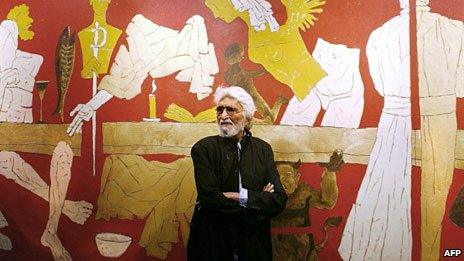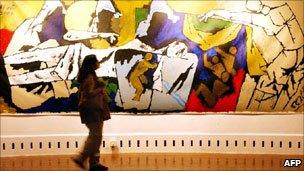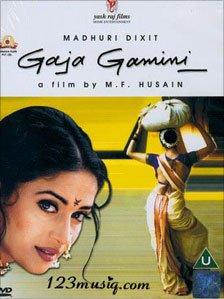Obituary: Iconic Indian artist MF Husain
- Published

MF Husain painted over more than six decades
Maqbool Fida Husain was India's most iconic and prolific artist - and painted right up until two weeks before his death in London at the age of 95.
"I have expressed only 10% - 90% is still inside. I don't think I will be able to do it, I think I have to take that with me to my grave," he told an interviewer last March.
His peers and admirers marvelled at the energy of this indefatigable painter - artist Anjolie Ela Menon says he "ran ahead of all of us - he had such energy".
So much so that he declared five years ago that he planned to work on "three major projects": histories of Indian civilisation, "other civilisations" and a history of "cinema which is close to my heart".
Maverick
Husain was a protean maverick who embraced the free market, took to making cinema, angered Hindu radicals at home with his provocative work, gamely took leaving India in his stride, accepted Qatari nationality and loved fast cars, including a red Ferrari that he owned.
When his admirers in India got worked up about his self-imposed exile, he calmly told an interviewer: "Nothing is stopping me; I can return tomorrow. But please know I remain an Indian painter whether I am painting in Paris, London, New York or Qatar."

Husain's works sold for millions of dollars
Husain was born in Pandharpur in Maharashtra in western India in 1915. His father was an accountant in a textile mill. His homemaker mother died when he was two years old.
Her passing made a strong impression on him "as seen in his portrayal of his mother", writes Najma Husain in her book, Husain's Art.
His artistic abilities were noticed by the family with his easy mastery of the Arabic calligraphy he had to learn as a young boy. Husain would sell his school books to buy painting materials and he loved to paint landscapes.
A self-taught artist, his impulses were awakened by the street art and the colours and sights he would observe as he rode his bicycle as a boy.
Husain travelled to Mumbai (then Bombay) from his home town as an 18-year-old to chase his dreams of being a filmmaker.
Bold lines
However his first job was painting cinema signboards to support his wife and family.
Working on billboards and hoardings helped him paint using bold lines and deep colours on large canvases when he turned to painting murals and large works of art.
He embraced the street around him, living in bazaar lanes where prostitutes and street vendors peddled their wares.
Husain rose to prominence as a painter in the 1940s.
Following India's independence he joined the Progressive Artist's Group, a bold new breed of artists like Francis Newton Souza, SH Raza and Akbar Padamsee.
The group wanted to break free from the traditions and sought freedom in content and technique.
Their bold themes were considered anarchic as they brought Indian elements to Expressionist styles and Cubist forms.

Husain made Gaja Gamini with Bollywood star Madhuri Dixit
Artists were considered an elite group who enjoyed the patronage of the royals in pre-Independence India. Husain's arrival on the art scene soon after Independence in 1947 was hailed as both anarchic and liberating.
Until his last he was considered a maverick, instantly recognisable with his uncombed mane of hair. He chose to go barefoot, like most poor Indians, twirling an oversized paint brush at posh parties and coffee shops.
Husain remained a painter who enjoyed street art, and the colour and popular forms of art.
But he was most captivated by the cinema and loved the moving images that had an impact until the very end of his career.
His first film Through the Eyes of a Painter was made in 1967 and won a Golden Bear at the Berlin Film Festival.
The Bollywood-loving artist also made films in Hindi that celebrated Indian women, especially peasants and women in traditional dress.
His series of lithographs and oils on Madhuri Dixit, a Bollywood diva of the 1990s, were very popular. He directed the film Gaja Gamini as a tribute to the actress in whom he said he had found a muse.
He also directed a film, Meenaxi - A Tale of Three Cities. The lead was played by another Bollywood actress, Tabu, whose grace Husain said inspired him to make the film.
High prices
Husain belongs to the elite club of Indian painters like Tyeb Mehta and SH Raza whose works have sold for more than $1m.
In 2008, Husain's Battle of Ganga and Yamuna sold at Christies for $1.6m even as protesters lined outside the auction house condemning him.
His critics accused him of selling out to the market, but Husain remained unfazed.
He would paint a mural as a gift after a good meal at a small roadside cafeteria in Calcutta and also draw huge crowds to his painting of a mural set to Indian classical music that was bought for an exorbitant amount.
Towards the end of his life Husain was attacked and reviled by right-wing groups and people who found his paintings of bare-breasted Hindu goddesses offensive.
He was dejected and left the country following court orders targeting his properties across India.
But he never showed any bitterness towards his homeland. "What has happened with me is a small thing. We remain a free country," he told an interviewer last year.
Husain's enduring legacy would be of a liberal who embraced all forms of beauty and colour around him. India's streets and culture remained his enduring inspiration.
"Is your life like a red Ferrari?" an interviewer asked him as he took to the wheels of his favourite car some time ago.
"You can say so," said Husain of a life lived to the brim.
Sudha G Tilak is a Delhi-based writer on art and culture.
- Published9 June 2011